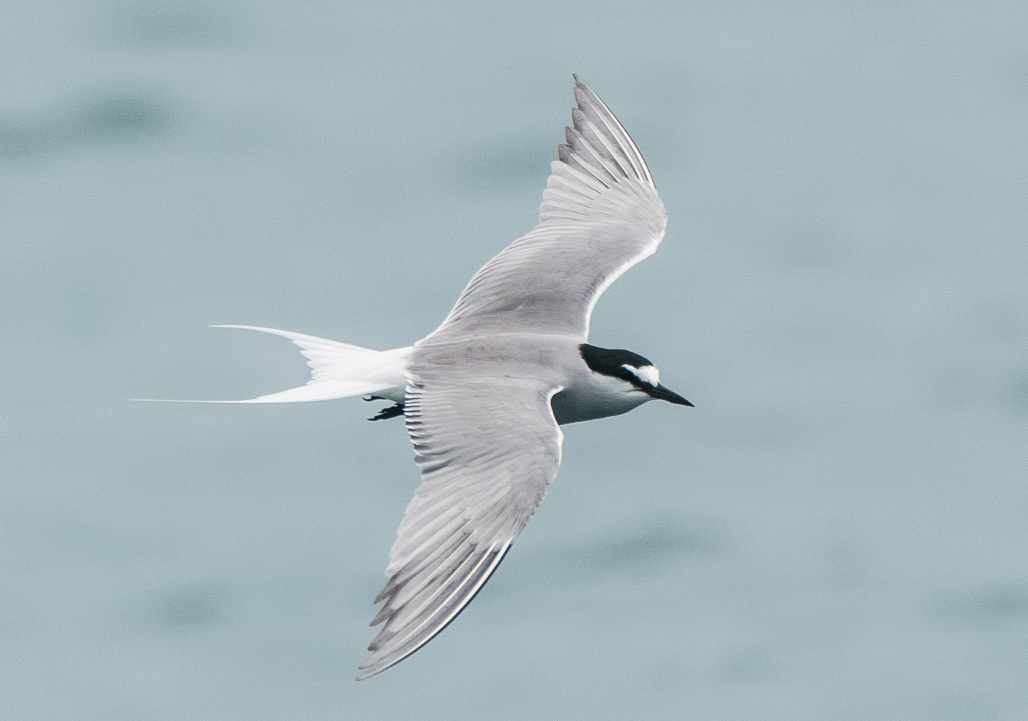
©️ Kenneth Lam
Common name: Aleutian Tern
Scientific name: Onychoprion aleutica
Local names: 白腰燕鸥 (Simplified Chinese), 白腰燕鷗(traditional Chinese), Алеутская крачка(Russian), 알류샨제비갈매기(Korean) , コシジロアジサシ(Japanese), Daralaut Aleutian (Indonesian), Camar Aleutian (Malayu).
Conservation status: IUCN - Vulnerable
Aleutian Tern (Onychoprion aleutica) is a representative of an East Asian-Australasian Flyway species. It is a medium-sized, coastal and colonial nesting seabird. The species was discovered in 1868 on Kodiak Island, Alaska, but studies are limited, mainly at breeding grounds. Its breeding ground Aleutian Tern is often found associated with Common Tern or Arctic Tern. The population of the bird is declining and listed as Vulnerable on the IUCN Red List.
Identification
- Size: 32-28cm; wingspan 75-80cm.
- Body: mid-grey back and has long wings, the underparts are a dark gray, while rump and forked tail are white
- Head: Breeding – adults have black cap and lore with a white forehead, chin, throat, and cheeks; Juvenile: brownish crown, and upper body
- Underwing: dark leading edges on secondaries are diagnostic for identication.
- Beak: Black
- Legs: Short and black
Distribution range
Breeding range:
at colonies in coastal Siberia, including Sakhalin Island, the Kamchatka Peninsula, the Sea of Okhotsk, and in the Bering Sea at Olyutortskiy Bay and Karagin Island, while in Southwest Alaska, they were found in Kasegaluk Lagoon, on the Seward Peninsula, the Yukon-Kuskokwim River Delta, and along the Alaska Peninsula, as well as the Aleutian Islands, Kodiak Archipelago, Kenai Peninsula, Copper River delta, and along the Gulf of Alaska as far east as Dry Bay.
Non-breeding range:
in spring and autumn offshore across the East Asia region covering waters in Japan, Korea, China, including Hong Kong and Taiwan, and the Philippines, and in winter found in the tropical western Pacific region including Indonesia, Malaysia and Thailand. Recent vagrant records reached Australia.
Habitat
The Aleutian tern breeds on wetlands and solitary rocky islands along coasts, particularly at river mouths, along with sparsely vegetated shorelines, grassy meadows, and marshes. It is pelagic during the non-breeding season.
Behavior
Breeding season occurs from May-August with egg-laying mostly in June, usually nesting among Arctic Terns in Alaska or Common Terns in Russia. Aleutian terns primarily feed on small fish, but also eat insects, crustaceans and zooplankton. They forage by flying, hovering low over water, and then surface-dip or pounce to take the food from the water surface.
Population estimate
About 31,000 mature individuals.
Main threats
- Habitat degradation
- Egg harvest and hunting
- Human disturbance
Natural threats:
- Natural predators (e.g. American Mink, Fox, rats) and domestic dogs
Conservation Work
Aleutian Tern Conservation Plan and a Statewide Aleutian Tern Colony Census Protocol in Alaska
As Aleutian Tern is a species of USFWS and ADF&G “Species of Conservation Concern/Species of Conservation Need”, in 2016, an Aleutian Tern Technical Committee (ATTC) was formally established. The ATTC has members include representatives from US’s federal and state agencies, scientists, and NGOs. ADF&G and collaborators. The recent population declines triggered an assessment of the status of the birds in 2017.
Fun Fact
- Aleutian Tern usually nests among Arctic Terns, who are known to be defensive of their nests, so they can take advantage of this behavior, while Aleutian Terns do not attempt to defend their own nests.

